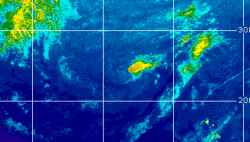vineyardsaker
Weather Guru

Reged:
Posts: 154
Loc: New Smyrna Beach, FL
|
|
I wonder, is there any possible link between the very active Pacific and the rather calm Atlantic this year?
In theory, are these two areas interecting with each other?
thanks!
VS
Edited by Ed Dunham (Sat Aug 02 2014 05:43 PM)
|
JoshuaK
Weather Guru
Reged:
Posts: 159
Loc: Lakeland, FL
|
|
I believe an El Nino event is normally responsible for an active Pacific theatre and a calm Atlantic theatre? The system I'm watching right now is Genevieve; If it reaches the Western Pacific, would it qualify as a system that's crossed all three Pacific Zones, or would it have to have been constantly monitored (in other words, not declared post-trop)?
EDIT: Super Typhoon Halong is looking pretty impressive on satellite imagery right now. Currently forecasted to affect the Ryukyu's as the equivalent of a Cat 3 Storm and then possibly Japan afterwards.
Edited by Ed Dunham (Sat Aug 02 2014 05:44 PM)
|
Ed Dunham
Former Meteorologist & CFHC Forum Moderator (Ed Passed Away on May 14, 2017)
Reged:
Posts: 2565
Loc: Melbourne, FL
|
|
An excellent question certainly worthy of its own thread. I've been working on an answer to this question for about six months and I'll post the results in a future Met Blog, but some of the initial results are interesting. High EASTPAC totals equate to low Atlantic totals exactly half of the time. Lower seasonal EASTPAC totals seldom equate to higher Atlantic seasonal totals (the exception was 2010). Lower Atlantic totals correlated well with higher EASTPAC numbers although sometimes the Pacific activity was still below normal (examples include 1965 and 1977). The busiest Atlantic seasons always had lower EASTPAC totals - although sometimes those totals were representative of a normal EASTPAC season rather than a 'quiet' one.
With regard to conditions, here is my response on June 12, 2007, to a similar question:
"About a month ago I did a little research from a slightly different angle. Since conditions are only available from 1950, I decided to check El Nino Region 3.4 anomalies against all of the very active seasons since 1950. I defined an active season as 14 named storms or more (there have been 10 of these) and neutral conditions as anything from +0.5C to -0.5C. I used the average sea surface temperature anomaly for the three month period of May, June and July (figuring that a three month lag was reasonable between Pacific conditions and Atlantic activity). The results coincide nicely with the findings of Ostro & Lyons.
1953...14 storms...+0.4 anomaly
1969...17 storms...+0.4 anomaly
1990...14 storms...+0.3 anomaly
1995...19 storms...+0.1 anomaly
1998...14 storms...+0.1 anomaly
2000...14 storms...-0.6 anomaly (weakening La Nina)
2001...15 storms...+0.1 anomaly
2003...15 storms.....0.0 anomaly
2004...15 storms...+0.4 anomaly
2005...28 storms...+0.3 anomaly
Conclusion: Although the dataset is limited, it appears that very active seasons generally occur under initially 'neutral' conditions. A strong La Nina doesn't really enhance activity, but a strong El Nino (1992, 1997, 2006) will limit activity."
Of course since that was posted in 2007 there have been many more active Atlantic seasons that may ultimately limit the usefulness of the above conclusion.
Cheers,
ED
|
B.C.Francis
Storm Tracker
Reged:
Posts: 332
Loc: Indiatlantic Florida
|
|
1977 season. What happened ?
|
Ed Dunham
Former Meteorologist & CFHC Forum Moderator (Ed Passed Away on May 14, 2017)
Reged:
Posts: 2565
Loc: Melbourne, FL
|
|
In 1977, the 3.4 Region SST for May/June/July was +0.4 or within the zone of Neutral conditions. Later that Summer, El Nino conditions started in the 3.4 Region in the August/September timeframe and lasted through February of 1978. Storm totals in the Atlantic were 6/5/1 and in the Pacific they were 8/4/0. The EASTPAC storm season ended on October 8th (about two months earlier than normal) primarily because the SSTs had increased to a +0.8 anomaly, i.e., a moderate El Nino had kicked in - so this was a rare case where a season with a low number of storms in the Atlantic basin did not equate to a significantly higher level of activity in the eastern Pacific.
ED
|




 Threaded
Threaded



